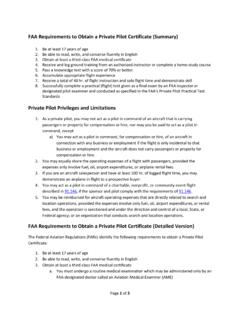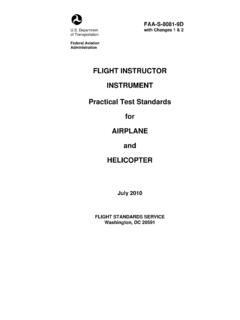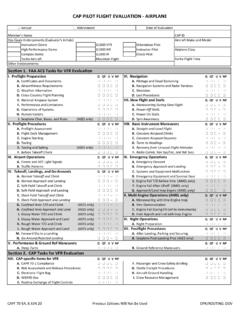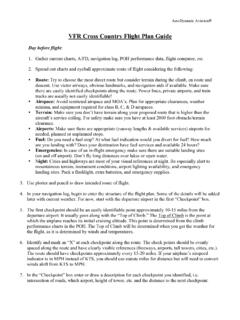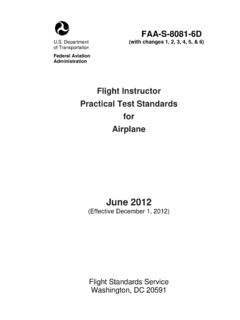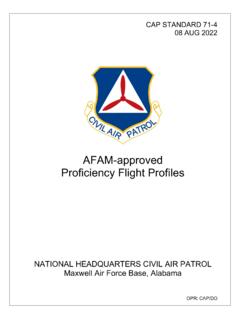Transcription of THE INSTRUMENT ‘KNOW ALL’ HANDOUT
1 THE INSTRUMENT KNOW ALL HANDOUT -Logging INSTRUMENT time: a. g(1) A person may log INSTRUMENT time only for that flight time when the person operates the aircraft solely by reference to instruments under actual or simulated INSTRUMENT flight conditions. (2)-an authorized instructor may log INSTRUMENT time when conducting INSTRUMENT flight instruction in actual INSTRUMENT conditions. b. g(3i-ii)(4) - location and type of each approach, safety pilot if required, flight simulator may be used by a person to log INSTRUMENT time provided an authorized instructor is present during the simulated flight . -To act as pilot in command of a civil aircraft under IFR (or weather less than the minimum required for VFR flight ) - pilot must have a current medical certificate and current INSTRUMENT rating -Recency experience requirements to act PIC under IFR: - within 6 months: - conduct 6 INSTRUMENT approaches, intercept and track navigational courses, and perform holding procedures.
2 - Have an additional six months after PIC currency expires (6 months) to complete these requirements before an INSTRUMENT -- Proficiency Check (IPC) is required ( ) - safety pilot must be rated in the same category and class of aircraft, with a current medical and private pilot cert. - Passenger currency is the same 90 rule: you may be INSTRUMENT current, but not to carry passengers if you haven t in the last 90 days performed 3 takeoffs and landings (full stop if tail dragger) in the same aircraft category, class, and type if it s required. o Night currency: 3 takeoffs and landings to a full stop, 1 hour after sunset to 1 hour before sunrise in same category, class, and type if it s required. -WHEN MUST WE FILE AN ALTERNATE: - Always, except when within 1 hour before ETA to 1 hour after ETA, the weather is forecasted to be 2000 and 3 miles visibility - If your airport of intended landing has only a GPS approach, you must file an alternate - WHAT ARE STANDARD ALTERNATE MINIMUMS ?
3 - precision approach: 600 and 2 miles visibility at ETA - non precision approach: 800 and 2 miles visibility at ETA - visual approach: descent from MEA and approach and landing done in VFR conditions (forecasted ceiling greater than MEA) - NON STANDARD: front pages of NOS, on airport diagrams in JEPP plates INSTRUMENT PRE- flight VFR DAY Inst & Equip. Req s ( ) VFR NIGHT ( ) INSTRUMENT ( )day=VFR day+ T-tachometer F-fuses (one full set, 3 of each kind) G-Generator/Alternator O-oil pressure gauge L-landing light R-radio (2 way comm. and nav approp) M-magnetic compass A-anti collision lights A-altimiter A-air speed indicator P-position lights B-ball T-temperature gauge (liq cooled) S-source of electrical power C-clock with second hand O-oil temp gauge (air cooled) A-attitude indicator F-fuel gauges R-rate of turn indicator L-landing gear position lights D-Directional Gyro A-altimeter D-DME above M-manifold pressure gauges (altitude engine) *IFR night=VFR day+night+grabcard E-ELT S-seat belts REQUIRED DOCUMENTS *AIRCRAFT AIRWORTHINESS A-Airworthiness Certificate A-annual inspection R-Registration V-VOR checks every 30 days R-radio license (intern.)
4 flight only) I-100 hour inspections (for hire only) O-operating limitations (placards, POH) A-AD s (one time and re-occurring) W-weight and balance T-Transponder (24 months) E-ELT (12 months, shelf life of battery, 1 cum hour of use) S-Static System (groups pitot system and altimeter) (24 months) *VOR equipment checks for IFR flight : - VOT: +/- 4 . Published in A/FD, tune , 180 TO/360 FROM - Ground checkpoint: +/- 4 , specific point on airport listed in A/FD - Airborne checkpoint: +/- 6 , located over easily identifiable terrain or features on the ground, listed in A/FD - VOR/VOR: +/- 4 , dual check in the air - VOR radial on airway centerline over identifiable ground point: +/- 6 - Radiated test signal by A & P only COMPASS ERRORS ACCELERATION ERRORS N. TURNING ERRORS V-Variation (True vs. Magnetic) A-Accelerate U-Undershoot D-Deviation (magnetic interference) N-North N-North M-Magnetic dip (pulls towards earth) D-Decelerate O-Overshoot O-Oscillation (turbulence, combination) S-South S-South N-Northerly Turning Errors (UNOS) A-Acceleration Errors (ANDS) LOST PROCEDURES GO AROUND/MISSED APPROACH 5 T s: HOLDING C-Climb C-Cram T-Turn C-Call/Communicate C-Climb T-Time C-Confess C-Clean T-Twist C-Comply C-Cool T-Throttle C-Conserve C-Call T-Talk MUST KNOW FOR flight 3 ERRORS OF INST SCAN TRANS CODES N-NOTAMS F-Fixation 1200- VFR 7500-HIJACK W-Weather O-Omission 7600-LOST COMM 7700-EMERG K-Known traffic delays E-Emphasis 7777-military int.
5 R-Runway Lengths FUNDAMENTAL SKILLS OF INST FLYING A-Alternates if needed INSTRUMENT Cross Check F-Fuel requirements (incl. alternate) INSTRUMENT Interpretation T-Takeoff/Landing Distances Aircraft Control VOR SERVICE VOLUMES and FREQUENCIES: -VHF Frequencies between MHz -Terminal VOR: 1,000 -12,000 25NM radius -Low Altitude VOR: 1,000 -18,000 40NM radius -High Altitude VOR: 1,000 -14,500 40NM; 14,500 -18,000 100NM; 18,000 -45,000 130NM; 45,000 -60,000 100NM radius MODE C TRANSPONDER REQUIREMENTS - Class A, B, and C airspace - Within 30 NM of class B - Above the ceiling within the lateral boundaries of class B or class C up to 10,000 MSL - ALL airspace at and above 10,000 MSL, excluding that airspace below 2,500 AGL - **there are a couple more less obvious ones, but these are the main ones we will deal with on a daily basis DECIDE MODEL I M SAFE CHECKLIST D-Detect I-Illness E-Estimate M-Medication C-Choose S-Stress I-Identify A-Alcohol D-Do F-Fatigue E-Evaluate E-Emotion/Eating WHAT ARE THE 3 DEFINIATIONS OF NIGHT, AND WHAT THEY ARE USED FOR?
6 - Sunset ( ): Beacons go on (plane and airport) - Evening civil twilight ( ): Generally 30 minutes after sunset (30 minutes before sunrise), this is used for logging night flight - 1 hour after sunset to 1 hour before sunrise ( ): If not night current, must be on the ground 59 minutes after sunset. This time however is where we can gain our night passenger currency by: o 3 takeoffs and landings to a full stop, acting as sole manipulator of the controls, and aircraft was same category, class, and type if type was required INSTRUMENT DEPARTURES: - DP s Departure Procedures: Either in front of NOS plates or right behind specific approach plates. Provides take off min s and transition from airport to en route. MUST have a textual description as a minimum in order to accept a Departure Procedure. If you don t want a DP, write NO DP in remarks section on flight plan. - If not given a DP, expect vectors from ATC until you are on course - Because we are Part 91, takeoff minimums do not apply to , if the BOEING aint going, I aint going either.
7 THE STRUCTURE OF AN INSTRUMENT flight - File a flight plan 30 minutes prior to departure - Once in the plane and we are started and ready to taxi, we call clearance delivery if the field has one, or we call ground if there is no ground. o Tacoma ground, Seminole 3005D at ATP w/ info Z, like to pick up our IFR clearance to KABC o They will respond with a clearance in which case we use the C-R-A-F-T model (see below) o Read back the clearance in full, then request taxi clearance - Conduct the run up, and at the conclusion maintain current location because sometimes it takes awhile to received an IFR release, and we don t want to block VFR traffic at the hold short line if they have a no delay departure o Tacoma Tower, Seminole 3005D holding short 17 for IFR release o Wait until released, then depart as instructed: at Tacoma narrows we are usually given the Narrows 1 departure (DP) - After takeoff, tower will instruct us to contact departure o Acknowledge this, and change frequencies while flying the clearance we were given o We Say: Seattle departure, Seminole 3005D is 1200 climbing 2000 o They Say.
8 Roger, Seminole 3005D radar contact, climb and o At this point, the rest of the flight is like having VFR flight following. They give us instructions and we abide, or if we cannot, let them know. - The enroute structure is simple, just follow instructions given by ATC - As we approach an airport, get current ATIS/ASOS at intended airport, figure out an approach to shoot, or if one is in effect, set up for that approach - Notify ATC of your intentions for the approach: what kind of approach, how it will terminate (practice approach to missed vs. full stop) - At least 15 miles from the airport, brief the approach per the ATP checklist - As we get closer to the airport, we will get handed off to the tower or to the airport CTAF to notify them of our position and intentions - REMEMBER: we always have to close/cancel our flight plan. o If we are at a controlled field with a tower operator currently working, they will close our flight plan for us.
9 O IF WE LAND AT AN UNCONTROLLED FIELD, WE MUST EITHER CANCEL WITH ATC IN THE AIR BEFORE WE LAND, OR ONCE WE ARE ON THE GROUND!!! DON T FORGET THIS IT SUCKS!!! o If we we are operating in VFR conditions which we will encounter for the remainder of our flight , and we are outside of positive control airspace, then we can cancel here as well IFR CLEARANCE (this is how we copy and read back our clearance once received) C-Clearance limit R-Route of flight A-Altitude F-Frequency for Departure T-Transponder code Clearance Void Time: Used by ATC when at an uncontrolled field. Somehow we need to get a release/clearance to depart, and if there is no tower, then we must: - find a frequency that will work on the ground to talk to ATC - call from a cell phone and get a clearance void time - PURPOSE: to advise an aircraft that the departure clearance is automatically canceled if takeoff is not made prior to a specified time.
10 The pilot must obtain a new clearance or cancel his/her IFR flight plan if not off by the specified time. CLIMB GRADIENT: - Some INSTRUMENT departures will have a minimum climb gradient you must be able to achieve in order to execute the departure successfully - This number is generally given in a FOOT/Nautical Mile quantity - We need to make this number tangible to us, so we will change it to FPM on our VSI o To calculate: (Ground Speed / 60) X Foot/NM requirement EX: 100 KIAS / 60 = X 300 Foot/NM = 500fpm - So, in this example, if we cannot obtain a 500 /minute climb on departure, we cannot execute this departure procedure INSTRUMENT EN-ROUTE PROCEDURES INSTRUMENT ALTITUDES - 0-179 = even thousands - 180-359 = odd thousands - ONE: ODD NORTH EAST IFR ALTITUDES - MEA: Minimum En-route Altitude is the lowest published altitude between radio fixes that guarantees adequate navigational signal reception and obstruction clearance of 1,000 in non mountainous and 2,000 in mountainous terrain.
